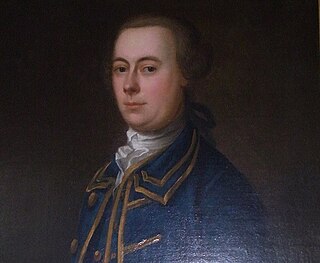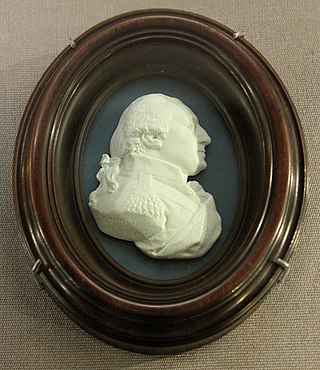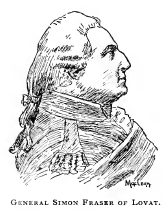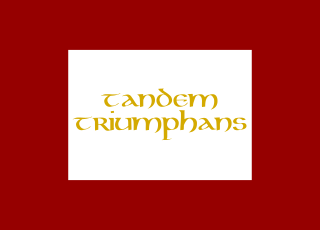
The Battle of Culloden took place on 16 April 1746, near Inverness in the Scottish Highlands. A Jacobite army under Charles Edward Stuart was decisively defeated by a British government force commanded by the Duke of Cumberland, ending the Jacobite rising of 1745.

The Highlands Services Act 1715, also known as the Disarming Act 1715, was an 18th-century Act of Parliament of Great Britain that was enacted to curtail Jacobitism among the Scottish clans in the Scottish Highlands after the Jacobite rising of 1715. The new law, which came into effect on 1 November 1716, aimed at "securing the peace of the highlands in Scotland". It outlawed anyone in defined parts of Scotland from having "in his or their custody, use, or bear, broad sword, poignard, whinger, or durk, side pistol, gun, or other warlike weapon" unless authorised.

A Scottish clan is a kinship group among the Scottish people. Clans give a sense of shared heritage and descent to members, and in modern times have an official structure recognised by the Court of the Lord Lyon, which regulates Scottish heraldry and coats of arms. Most clans have their own tartan patterns, usually dating from the 19th century, which members may incorporate into kilts or other clothing.

The Dress Act 1746, also known as the Disclothing Act, was part of the Act of Proscription which came into force on 1 August 1746 and made wearing "the Highland Dress" — including the kilt — by men and boys illegal in Scotland north of the Highland line running from Perth in the east to Dumbarton in the west. The rest of the Act of Proscription reiterated and reinforced the Disarming Act 1715. The Jacobite risings between 1689 and 1746 found their most effective support amongst the Scottish clans, and this act was part of a series of measures attempting to bring the clans under government control. An exemption allowed the kilt to be worn in the army's Highland regiments along with its veterans who had served in the military. The landed gentry were also exempt, being exempt from the entire Act of Proscription.
A dirk is a long-bladed thrusting dagger. Historically, it gained its name from the Highland dirk where it was a personal weapon of officers engaged in naval hand-to-hand combat during the Age of Sail as well as the personal sidearm of Highlanders. It was also the traditional sidearm of the Highland Clansman and later used by the officers, pipers, and drummers of Scottish Highland regiments around 1725 to 1800 and by Japanese naval officers.

Sir Harry Munro, 7th Baronet was 25th Baron and the 28th chief of the Clan Munro. He was a Scottish soldier and politician. He was loyal to the Hanoverian dynasty and served as a captain in Loudon's Highlanders Regiment 1745–48.

The history of the modern kilt stretches back to at least the end of the 16th century. The kilt first appeared as the belted plaid or great kilt, a full-length garment whose upper half could be worn as a cloak draped over the shoulder, or brought up over the head as a hood. The small kilt or walking kilt did not develop until the late 17th or early 18th century, and is essentially the bottom half of the great kilt.

Archibald Campbell Fraserof Lovat, was British consul at Tripoli and Algiers, and later colonel of the 1st Inverness local militia. Upon the death of his brother, Simon Fraser (1726–1782), Archibald became the 20th MacShimidh (chief) of Clan Fraser of Lovat, and sat in the House of Commons from 1782 to 1784.

The Scottish Gaelic word clann means children. In early times, and possibly even today, Scottish clan members believed themselves to descend from a common ancestor, the founder of the clan, after whom the clan is named. The clan chief is the representative of this founder, and represents the clan. In the Scottish clan system, a chief is greater than a chieftain (ceann-cinnidh), a designation applied to heads of branches of a clan. Scottish clans that no longer have a clan chief are referred to as armigerous clans.

Simon Fraser of Lovat was a son of a notorious Jacobite clan chief, but he went on to serve with distinction in the British army. He also raised forces which served in the Seven Years' War against the French in Quebec, as well as the American War of Independence. Simon was the 19th Chief of the Clan Fraser of Lovat.

Donald Cameron of Lochiel, popularly known as the Gentle Lochiel, was a Scottish Jacobite, soldier and hereditary chief of Clan Cameron, traditionally loyal to the exiled House of Stuart. His support for Charles Edward Stuart proved pivotal in the early stages of the 1745 Rising. Lochiel was among the Highlanders defeated at the Battle of Culloden, and thereafter went into hiding before eventually fleeing to France.
Loudon's Highlanders, or the 64th Highlanders, or Earl of Loudon's Regiment of Foot, was an infantry regiment of the British Army.

The Heritable Jurisdictions (Scotland) Act 1746 was an Act of Parliament passed in the aftermath of the Jacobite rising of 1745 abolishing judicial rights held by Scots heritors. These were a significant source of power, especially for clan chiefs since it gave them a large measure of control over their tenants.

The Jacobite rising of 1745 was an attempt by Charles Edward Stuart to regain the British throne for his father, James Francis Edward Stuart. It took place during the War of the Austrian Succession, when the bulk of the British Army was fighting in mainland Europe, and proved to be the last in a series of revolts that began in March 1689, with major outbreaks in 1715 and 1719.
The Independent Highland Companies were irregular militia raised from the Scottish clans of the Scottish Highlands by order of the British government between 1603 and 1760 in order to help keep the peace and enforce the law in the Highlands and were recognized as such by the government. The officers of the Independent Highland Companies were commissioned as officers of the British Army but the Independent Companies were not recognized as official regiments of the line of the army. The Independent Highland Companies were the progenitors of the Highland Regiments of the British Army that began when ten Independent Highland Companies were embodied to form the Earl of Crawford's Highland Regiment that was numbered the 43rd Regiment of Foot in 1739.
The Campbell of Argyll Militia also known as the Campbell militia, the Argyll militia, or the Argyllshire men, was an irregular militia unit formed in 1745 by John Campbell, 4th Duke of Argyll to oppose the Jacobite rising of 1745.

The Killin incident of 1749 took place in August 1749 in Killin in the Scottish Highlands in the tumultuous aftermath of the Jacobite rising of 1745. Two men who had been plundering at will in full Highland dress after the Dress Act 1746 had made it illegal to wear it, had been captured by soldiers of the British Army, but a large mob secured their release.

The Jacobite Army, sometimes referred to as the Highland Army, was the military force assembled by Charles Edward Stuart and his Jacobite supporters during the 1745 Rising that attempted to restore the House of Stuart to the British throne.

Duncan Forbes 5th of Culloden was a Scottish lawyer and Whig politician who sat in the House of Commons from 1721 to 1737. As Lord President and senior Scottish legal officer, he played a major role in helping the government suppress the 1745 Jacobite Rising.

An Incident in the Rebellion of 1745 is an oil painting painted by Swiss-born artist David Morier which was made between 1746 and 1765. It currently forms part of the art collection of the British royal family. The painting depicts a scene during the 1746 Battle of Culloden, in which a group of Jacobite Army troops charge against a line of government soldiers.













